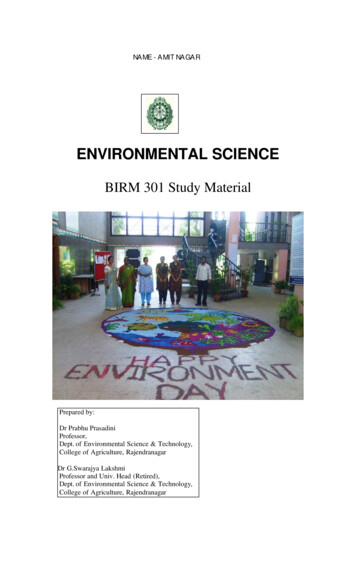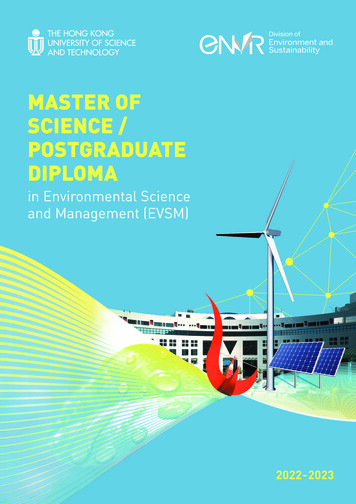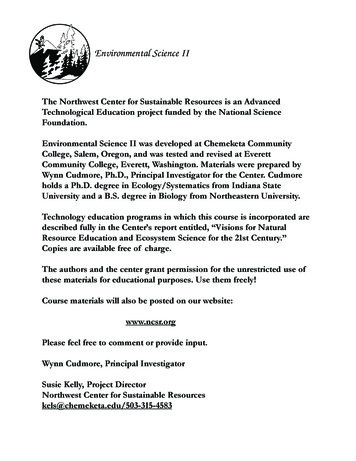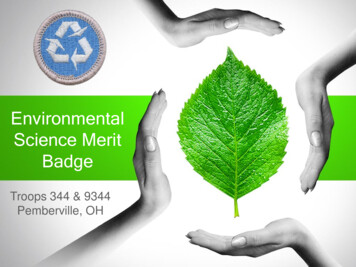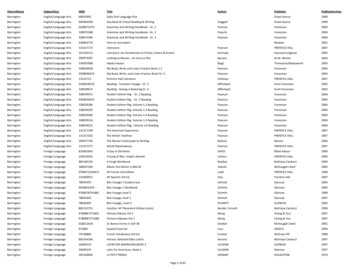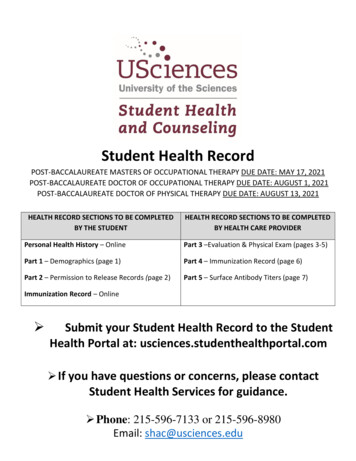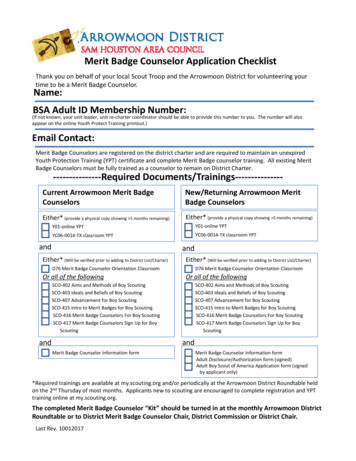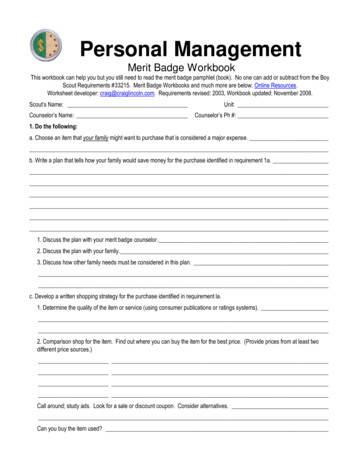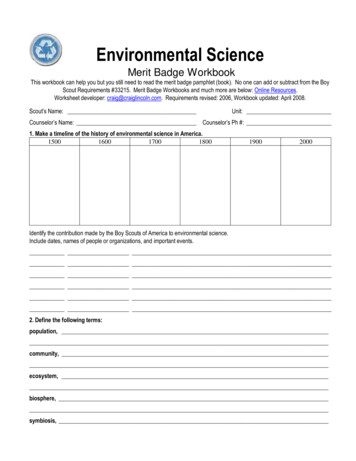
Transcription
Environmental ScienceMerit Badge WorkbookThis workbook can help you but you still need to read the merit badge pamphlet (book). No one can add or subtract from the BoyScout Requirements #33215. Merit Badge Workbooks and much more are below: Online Resources.Worksheet developer: craig@craiglincoln.com. Requirements revised: 2006, Workbook updated: April 2008.Scout’s Name:Unit:Counselor’s Name: Counselor’s Ph #:1. Make a timeline of the history of environmental science in America.150016001700180019002000Identify the contribution made by the Boy Scouts of America to environmental science.Include dates, names of people or organizations, and important events.2. Define the following biosis,
Environmental Science p. 2Merit Badge WorkbookScout's Name:niche,habitat,conservation,threatened species,endangered species,extinctionpollution oint source,hybrid vehicle,fuel cell.3. Do ONE activity in EACH of the following categories (using the activities in this pamphlet as the bases for planningand carrying out your projects):A. Ecology1. Conduct and experiment to find out how living things respond to changes in their environments. Discuss your observations withyour counselor. -OR2. Conduct an experiment illustrating the greenhouse effect. Keep a journal of your data and observations. Discuss yourconclusions with your counselor. -OR-
Environmental Science p. 3Merit Badge WorkbookScout's Name:3. Discuss what is an ecosystem. Tell how it is maintained in nature and how it survives.B. Air Pollution1. Perform an experiment to test for particulates that contribute to air pollution. Discuss your findings with your counselor. -OR2. Record the trips taken, mileage, and fuel consumption of a family car for seven days, and calculate how many miles per gallonthe car gets. Determine whether any trips could have been combined ("chained") rather than taken out and back. Using the idea oftrip chaining, determine how many miles and gallons of gas could have been saved in those seven days. -OR3. Explain what is acid rain. In your explanation, tell how it affects plants and the environment and the steps society can take tohelp reduce its effects.C. Water Pollution1. Conduct an experiment to show how living things react to thermal pollution. Discuss your observations with your counselor. OR2. Conduct an experiment to identify the methods that could be used to mediate (reduce) the effects of an oil spill on waterfowl.Discuss your results with your counselor. -OR-
Environmental Science p. 4Merit Badge WorkbookScout's Name:3. Describe the impact of a waterborne pollutant on an aquatic community. Write a 100-word report on how that pollutant affectedaquatic fife, what the effect was, and whether the effect is linked to biomagnification.D. Land Pollution1. Conduct an experiment to illustrate soil erosion by water. Take photographs or make a drawing of the soil before and after yourexperiment, and make a poster showing your results. Present your poster to your patrol or troop. (Per National, “troop” means“unit”.) -OR2. Perform an experiment to determine the effect of an oil spill on land. Discuss your conclusions with your counselor. -OR3. Photograph an area affected by erosion. Share your photographs with your counselor and discuss why the area has erodedand what might be done to help alleviate the erosion.E. Endangered Species1. Do research on one endangered species found in your state. Find out what its natural habitat is, why it is endangered, what isbeing done to preserve it, and how many individual organisms are left in the wild. Prepare a 100-word report about the organism,including a drawing. Present your report to your patrol or troop. -OR2. Do research on one species that was endangered or threatened but which has now recovered. Find out how the organismrecovered, and what its new status is. Write a 100-word report on the species and discuss it with your counselor. -OR3. With your parent's and counselor's approval, work with a natural resource professional to identify two projects that have beenapproved to improve the habitat for a threatened or endangered species in your area. Visit the site of one of these projects andreport on what you saw.
Environmental Science p. 5Merit Badge WorkbookScout's Name:F. Pollution Prevention, Resource Recovery, and Conservation1. Look around your home and determine 10 ways your family can help reduce pollution. Practice at least two of these methods forseven days and discuss with your counselor what you have learned. -OR2. Determine 10 ways to conserve resources or use resources more efficiently in your home, at school, or at camp. Practice atleast two of these methods for seven days and discuss with your counselor what you have learned. -OR3. Perform an experiment on packaging materials to find out which ones are biodegradable. Discuss your conclusions with yourcounselor.4. Choose two outdoor study areas that are very different from one another (e.g., hilltop vs. bottom of a hill; field vs. forest; swampvs. dry land). For BOTH study areas, do ONE of the following:a. Mark off a plot of 4 square yards in each study area, and count the number of species found there. Estimate how much space isoccupied by each plant species and the type and number of non-plant species you find.Study Plot Location: Number of Species:Species# FoundSpace each occupies
Environmental Science p. 6Non-plant species typeMerit Badge WorkbookNumberScout's Name:Non-plant species type Number-OR- b. Make at least three visits to each of the two study areas (for a total of six visits), staying for at least 20 minutes each time,to observe the living and nonliving parts of the ecosystem. Space each visit far enough apart that there are readily apparentdifferences in the observations. Keep a journal that includes the differences you observe. Then, write a short report thatadequately addresses your observations, including how the differences of the study areas might relate to the differences noted,and discuss this with your counselor.Visit 1 Date: Time Started: Time Ended:Observations of living parts:Observations of nonliving parts:Differences noted:Visit 2 Date: Time Started: Time Ended:Observations of living parts:Observations of nonliving parts:Differences noted:Visit 3 Date: Time Started: Time Ended:Observations of living parts:Observations of nonliving parts:Differences noted:
Environmental Science p. 7Merit Badge WorkbookScout's Name:Then, write a short report that adequately addresses your observations, including how the differences of the study areas mightrelate to the differences noted, and discuss this with your counselor.5. Using the construction project provided or a plan you create on your own, identify the items that would need to be included in anenvironmental impact statement for the project planned.6. Find out about three career opportunities in environmental science.Pick one and find out the education, training, and experience required for this profession.Discuss this with your counselor, and explain why this profession might interest you.Online Resources (Use any Internet resource with caution and only with your parent’s or guardian’s permission.)Boy Scouts of America: scouting.org Guide to Safe Scouting Age-Appropriate Guidelines Safe Swim Defense Scout Tenderfoot Second Class First Class Rank Videos Safety AfloatBoy Scout Merit Badge Workbooks: usscouts.org -or- meritbadge.orgMerit Badge Books: www.scoutstuff.orgAdvocacy Organizations: http://www.saveourenvironment.org Earth 911: http://www.earth911.orgEndangered Species: http://endangered.fws.govEnvironmental Protection Agency: http://www.epa.govKeep America Beautiful: http://www.kab.orgLeave No Trace Center: http://www.LNT.orgNat. Climatic Data Center: http://lwf.ncdc.noaa.gov/oa/ncdc.htmlNat. Fish and Wildlife Foundation: http://www.nfwf.orgNat. Park Service: http://www.nps.govNatural Resources Cons. Service: http://www.nrcs.usda.govSierra Club: http://www.sierraclub.orgSociety of American Foresters: http://www.safnet.orgU.S. Fish and Wildlife Service: http://www.fws.govUSDA Forest Service: http://www.fs.fed.usWildlife Conservation Society: http://wcs.orgWorld Wildlife Fund: http://www.worldwildlife.org
This workbook can help you but you still need to read the merit badge pamphlet (book). No one can add or subtract from the Boy Scout Requirements #33215. Merit Badge Workbooks and much more are below: Online Resources. Worksheet developer: craig@craiglincoln.com. Requirements revised: 2006, Workbook updated: April 2008.
